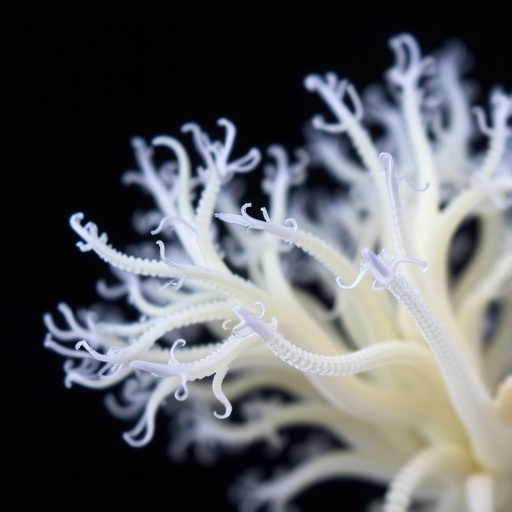In an era where sustainability is becoming increasingly crucial, the valorization of agricultural and food waste is gaining attention as a viable solution for environmental issues. Recent research highlights the role of food-grade microorganisms, particularly the bacterium Bacillus amyloliquefaciens, in transforming feather waste into valuable bioproducts. Conducted by Hussain et al., this study sheds light on the innovative use of Bacillus amyloliquefaciens NS56 as a whole cell biocatalyst, setting the stage for new methods of waste treatment that align with the principles of a circular economy.
The feather waste produced by the poultry industry represents a significant environmental challenge. With billions of tons of feathers discarded annually, these organic materials are often left to decompose, contributing to pollution and waste accumulation. The need for an efficient method to recycle and repurpose feather waste is more pressing than ever. The findings of this study propose an effective pathway that not only addresses waste management but also harnesses biotechnological advancements to generate useful products from what is typically considered refuse.
Bacillus amyloliquefaciens is known for its versatility and ability to thrive in diverse environments. As a non-pathogenic bacterium, it is widely used in agriculture and food industries due to its fermentation capabilities and production of bioactive compounds. This study explores its application beyond traditional domains, positioning it at the forefront of biocatalytic processes aimed at valorizing feather waste. By utilizing the inherent enzymatic properties of NS56, researchers can convert keratin—a protein that constitutes over 90% of feather material—into simpler, more usable forms.
The researchers utilized various fermentation techniques to analyze the bioconversion efficiency of Bacillus amyloliquefaciens. Initial experiments focused on optimizing growth conditions, such as temperature, pH, and nutrient availability, to enhance the bacterium’s performance in degrading keratin-rich substrates. Through systematic optimization, the study determined the ideal conditions for maximum enzyme production, which subsequently led to increased keratinase activity, facilitating the degradation process.
One of the significant findings of this research is the efficiency of Bacillus amyloliquefaciens in hydrolyzing keratin into soluble peptides and amino acids. These breakdown products have vast applications in the food, cosmetics, and pharmaceutical industries. In food applications, the amino acids released can serve as essential nutrients, while in cosmetics, they can act as moisturizing and skin-repairing agents. The study highlights the economic potential of valorizing feather waste by transforming it into high-quality, marketable products.
Moreover, this research underscores the environmentally friendly nature of using Bacillus amyloliquefaciens as a biocatalyst. Traditional methods for feather disposal often involve chemical treatments or incineration, which can lead to environmental pollution and health hazards. In contrast, utilizing a whole cell biocatalyst offers a sustainable and non-toxic alternative, significantly reducing the ecological footprint associated with feather waste management.
Another critical aspect of this study is the assessment of bioprocess scalability. Researchers evaluated the viability of scaling up the process from laboratory settings to pilot and industrial scales. They acknowledged that process scale-up is a critical step for the practical application of biocatalytic systems in waste valorization. The findings suggest that with the right adjustments in operating parameters, the method can be efficiently adapted for large-scale implementations, potentially transforming the poultry industry’s waste management practices.
As industries around the world strive to enhance sustainability, the insights from this study may pave the way for integrating bioprocessing technologies into everyday practices. The successful application of Bacillus amyloliquefaciens NS56 as a biocatalyst exemplifies the intersection of biotechnology and sustainability. This research not only addresses waste recycling but also emphasizes the potential for generating economic benefits through innovative biotechnological solutions.
The implications of these findings extend beyond feather waste alone. The methodologies developed can be adapted to other agricultural by-products, indicating a broader applicability of this biocatalytic approach. By exploring the use of various environmental strains of Bacillus amyloliquefaciens, future studies can expand on the range of feedstocks applicable to bioconversion processes, further optimizing waste management strategies across different sectors.
Industry stakeholders might find the results of this study promising, particularly in the context of corporate social responsibility and sustainable development goals (SDGs). Companies engaged in poultry production are under increasing pressure to adopt eco-friendly practices, and methods that efficiently recycle waste can provide a competitive advantage. As consumers become more environmentally conscious, the ability to market products derived from sustainably managed waste can enhance a brand’s image and foster customer loyalty.
It’s also noteworthy that the research opens avenues for collaborative efforts between academia and the poultry industry. By jointly tackling the issue of feather waste, stakeholders from both sectors can benefit from shared knowledge and resources. This synergy can lead to innovations that not only advance scientific understanding but also have practical applications that can be realized in the marketplace.
Finally, the work of Hussain et al. sparks a call to action for continued research into biocatalysts and their applications in waste valorization. The field of biotechnology is replete with opportunities for discovery and innovation. This study serves as an encouraging example of how scientific advancements can directly contribute to solving pressing environmental challenges, underlining the importance of cross-disciplinary collaboration to foster sustainable solutions.
In conclusion, the valorization of feather waste using Bacillus amyloliquefaciens NS56 represents a significant advancement in sustainable bioprocessing. By transforming a seemingly useless waste product into valuable resources, this research not only supports environmental sustainability but also demonstrates the potential for biotechnology to generate economic opportunities. These findings pave the way for further innovations in waste management strategies and highlight the critical role of microbial processes in creating a more sustainable future.
Subject of Research: The role of Bacillus amyloliquefaciens in feather waste valorization.
Article Title: Food-Grade Bacillus amyloliquefaciens NS56 as a Whole Cell Biocatalyst for Sustainable Feather Waste Valorization.
Article References:
Hussain, N., Tariq, M., Yan, M. et al. Food-Grade Bacillus amyloliquefaciens NS56 as a Whole Cell Biocatalyst for Sustainable Feather Waste Valorization.
Waste Biomass Valor (2025). https://doi.org/10.1007/s12649-025-03352-7
Image Credits: AI Generated
DOI:
Keywords: Sustainability, Biocatalysis, Waste Valorization, Bacillus amyloliquefaciens, Feather Waste, Circular Economy.




